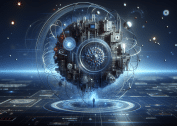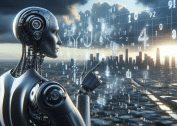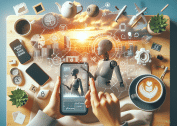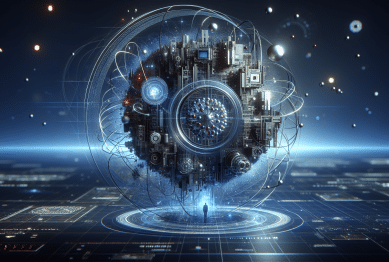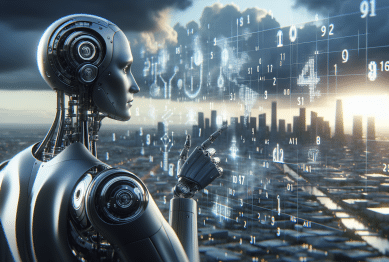Curiosity about artificial intelligence is reshaping how we work, learn, and connect. This guide breaks down emerging technologies such as machine learning, neural networks, natural language processing, and automation—making complex ideas simple and practical for everyday life. Dive into real-world impacts, opportunities, and the decisions that shape the tech-driven world you experience.
Unlocking Artificial Intelligence in Daily Life
Artificial intelligence, often shortened to AI, is becoming an ever-present part of day-to-day living. Whether searching for directions, using smart home devices, or scrolling social media, AI quietly powers these experiences behind the scenes. At its core, artificial intelligence aims to mimic human thinking and learn from patterns—making each digital touchpoint more intuitive over time. This adaptation is possible thanks to advances in machine learning algorithms, which allow machines to interpret vast quantities of data. The more these systems process, the smarter their responses become. You might notice subtle improvements in voice recognition or even the relevance of internet search results. Each tweak hints at the depth and breadth of AI’s influence, spanning from entertainment recommendations to complex problem-solving in research.
AI’s blend of automation and decision-making helps people streamline daily routines. Scheduling tools, for example, can automatically suggest optimal meeting times based on calendar data and prior habits. Smart thermostats adjust home temperatures to maximize comfort and save energy by learning household preferences. In the workplace, AI chatbots answer questions, filter emails, and automate routine tasks, freeing time for more creative work. Healthcare professionals use artificial intelligence to sift through medical records, identify trends, and even suggest potential diagnoses, which amplifies patient care without replacing the essential human touch. Across multiple sectors, from education to agriculture, artificial intelligence increases efficiency and reliability, making it an invisible yet essential partner for many.
One vital aspect of AI’s integration into daily life is its capacity to adapt through machine learning. Unlike traditional software, which rigidly follows pre-set commands, AI systems evolve through feedback and new data. When a streaming service refines movie suggestions or a navigation app learns your preferred routes, it reflects ongoing learning within the system. This adaptability prompts new discussions and considerations regarding privacy, transparency, and responsibility. Staying informed about how artificial intelligence is used—and evolving—is central to making empowered choices about technology’s influence on everyday life. Information and critical thought are powerful tools as AI becomes even more interconnected with routine activities.
Machine Learning: The Engine Behind Smart Systems
At the heart of modern artificial intelligence lies machine learning, an area of computer science that empowers machines to recognize patterns and improve outcomes based on experience. Unlike coding specific instructions, machine learning lets computers build knowledge from vast quantities of examples. For instance, by scanning thousands of medical images, a system can learn to distinguish between healthy and abnormal cells—sometimes spotting tiny details that might escape the unaided eye. The result is not just faster data analysis but also the ability to handle ever-increasing complexity in fields ranging from finance to environmental science.
Supervised learning, a popular technique in machine learning, involves teaching systems by example. Given a large set of labeled data, such as identified pictures of cats and dogs, a system uses these as references to classify new, unlabeled items in the future. Over time, algorithms refine their decision-making, reducing mistakes and increasing reliability. Unsupervised learning explores patterns and groupings without labeled examples—useful when researchers want to uncover hidden relationships in large or unstructured sets of data. Reinforcement learning trains systems using feedback from their own actions, similar to how humans improve skills through trial and error, making this an increasingly important approach in areas like robotics and game strategy.
Businesses and institutions continue to deepen their interest in machine learning, particularly where tasks are repetitive, data-heavy, or benefit from predictive insights. For example, banks deploy AI to monitor for suspicious transactions and potential fraud, refining models as new threats emerge. Retailers lean on machine learning for inventory planning and customer personalization, anticipating trends before they fully materialize. The adaptability of machine learning allows for constant improvement without needing new programming for each possibility. This flexibility ensures that intelligent systems improve alongside shifting expectations and growing datasets, making machine learning indispensable for the future of intelligent automation (see https://ai.gov/).
Understanding Neural Networks and Deep Learning
Neural networks are fundamental models in artificial intelligence, inspired by the human brain’s structure. They consist of layers of interconnected nodes, or “neurons,” that process and pass on information. Each connection has a weight that adjusts as the network learns. Deep learning refers to using large neural networks with many layers to solve complex problems—enabling breakthroughs in image recognition, natural language understanding, and even autonomous vehicles. These AI models can identify patterns or interpret information with remarkable accuracy, even when dealing with messy, real-world data.
The development of deep learning has enabled machines to tackle tasks previously thought exclusive to humans, such as translating languages or detecting objects in photos. For instance, AI-powered translation tools use deep neural networks to capture subtle nuances, making cross-language communication smoother. In the automotive industry, self-driving cars analyze surroundings via deep learning, interpreting road signs, lane markings, and moving hazards. Neural networks continuously update their understanding, which is why speech recognition and predictive text improve with usage over time.
The potential for neural networks in medicine is profound. Algorithms trained on thousands of scans can identify patterns that support early diagnosis or recommend treatment options. In the realm of cybersecurity, neural networks adapt to new threats by learning from fresh data streams, making digital environments safer. These models benefit from the ability to generalize from complex data, making decisions in environments where traditional programming would struggle. As computational power and accessible datasets expand, neural networks continue to drive advancement across industries, signaling even bigger changes ahead (https://www.nibib.nih.gov/science-education/science-topics/artificial-intelligence).
Natural Language Processing and Real-World Connections
Natural language processing, or NLP, is a field of AI focused on understanding and generating human language. NLP forms the backbone of chatbots, virtual assistants, language translation services, and sentiment analysis in social media monitoring. Its algorithms enable systems to identify context, decipher meaning, and even detect emotion from text or speech. These capabilities make digital conversations, searches, and content recommendations more natural and interactive. With voice activation and smart speakers, NLP acts as a bridge between people and technology, providing seamless access to information and services.
Modern advancements in NLP have led to more nuanced understanding of human intent. Complex tasks—such as summarizing news articles, answering questions, or translating idioms—become feasible at scale. This technology sorts customer feedback, scans for urgent trends, and flags content violations in real-time. Law firms, researchers, and marketers leverage NLP to extract valuable insights from vast text collections, automating previously time-consuming processes. Such wide-ranging applications demonstrate how NLP weaves artificial intelligence into countless aspects of daily and professional life, often without direct notice.
As AI language models improve, so too does the quality and trustworthiness of their responses. Training on massive collections of books, websites, and industry data helps these models generate sensible, context-rich answers. In health care, NLP helps parse clinical notes, improving continuity of care. In education, it powers automated grading and personalized learning. These advances come with the need for ethical guidelines, especially regarding data privacy and fairness—ensuring AI decisions are accountable and unbiased. Ongoing research remains crucial for maximizing NLP’s benefits while safeguarding human interests (https://www.nist.gov/artificial-intelligence).
Automation and the Future of Work
Automation, driven by artificial intelligence, is shifting how tasks are performed across professions. Robotic process automation (RPA) manages repetitive workflows, reducing human error and increasing productivity. Manufacturers embrace AI-controlled robots to assemble, test, and package products with high efficiency. In logistics and retail, automated sorting and delivery systems optimize speed and accuracy—contributing to smoother operations and consistently high customer satisfaction. AI-driven automation isn’t about replacing humans. Rather, it assists in handling the repetitive, predictable parts of a job, allowing focus on creative, strategic, or interpersonal responsibilities.
New types of jobs emerge alongside increased automation. Data analysts, AI trainers, and ethics specialists examine and improve automated systems. Remote collaboration platforms harness AI to coordinate teams, schedule projects, and track progress, regardless of location. Even creative industries are enhanced—generating music, art, or marketing copy with machine assistance. Adaptability, lifelong learning, and digital literacy help people navigate a work environment that evolves with technology. Understanding which skills complement AI can turn tech changes into growth opportunities.
Automation isn’t limited to physical tasks; it transforms knowledge work as well. AI-powered document review accelerates legal casework. Automated trading algorithms process vast financial data in milliseconds. In education, personalized learning platforms adjust lesson plans to suit student progress, enhancing outcomes. As artificial intelligence becomes increasingly central to economic growth, dialogue around equity, ethics, and digital access ensures technology serves the broadest possible benefit. Forward-thinking policies and effective upskilling equip society for a workforce shaped by smart automation (https://www.nasscom.in/knowledge-center/publications/impact-ai-future-workforce).
Ethics, Privacy, and Trust in Artificial Intelligence
Artificial intelligence presents unique challenges concerning ethics, privacy, and trust. Decisions made by algorithms can shape everything from credit scores to job applications, so the integrity of AI systems is essential. Data privacy becomes especially urgent as more personal information fuels smarter models. Ensuring AI systems remain transparent, explainable, and free of bias stands at the heart of responsible AI development. Major organizations advocate for guideline frameworks that emphasize accountability and public understanding in all applications of artificial intelligence.
Bias in AI training data is an ongoing concern. If the data a system learns from reflects historical inequalities or prejudices, the resulting decisions may reinforce or amplify those biases. Researchers and engineers now prioritize developing “fair” algorithms—testing systems for unintended consequences and improving their ability to make equitable decisions. Open-source models and transparent reporting help peer review uncover flaws and accelerate trust-building within communities. These practices support safe, trustworthy, and responsible use of artificial intelligence across all fields.
Regulatory efforts and industry coalitions explore how to strike the right balance between innovation and oversight. Public policy discussions tend to highlight the need for consent, secure data handling, and ongoing monitoring. Future advances in AI will depend as much on technical breakthroughs as on ethical and legal stewardship. As more people rely on intelligent systems, building trust through transparent, user-centric design remains a top priority. Understanding both the power and the limits of AI supports informed decisions and stronger confidence in technology’s expanding role (https://ai.facebook.com/blog/a-blueprint-for-the-future-of-ai).
References
1. U.S. Artificial Intelligence Initiative Office. (n.d.). About AI. Retrieved from https://ai.gov/
2. National Institute of Biomedical Imaging and Bioengineering. (n.d.). Artificial Intelligence. Retrieved from https://www.nibib.nih.gov/science-education/science-topics/artificial-intelligence
3. National Institute of Standards and Technology. (n.d.). Artificial Intelligence. Retrieved from https://www.nist.gov/artificial-intelligence
4. NASSCOM. (n.d.). Impact of AI on the Future Workforce. Retrieved from https://www.nasscom.in/knowledge-center/publications/impact-ai-future-workforce
5. Facebook AI Research. (n.d.). Blueprint for the Future of AI. Retrieved from https://ai.facebook.com/blog/a-blueprint-for-the-future-of-ai
6. Brookings Institution. (n.d.). AI and the Future of Work. Retrieved from https://www.brookings.edu/research/ai-and-the-future-of-work/



